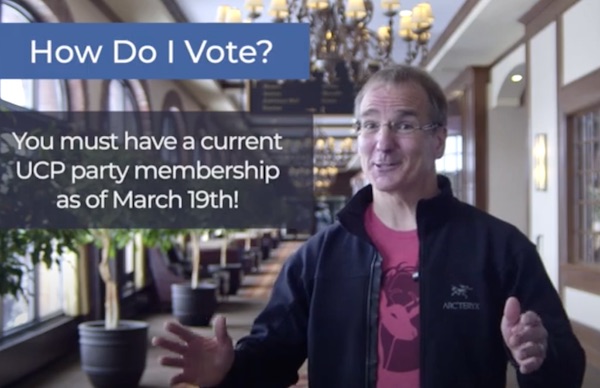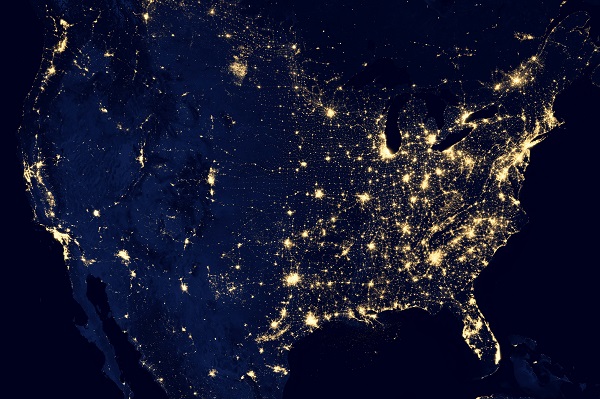Alberta
Red Deer South MLA Jason Stephan strongly urges Central Albertans to participate in the upcoming Leadership Review

Leadership Review of Jason Kenney in Red Deer
On Saturday, April 9, Alberta conservatives, of which there are many in Central Alberta, will have the opportunity to decide whether it is time to change the leader of the United Conservative Party. The vote will occur at the Cambridge Hotel in Red Deer.
What is the purpose of the leadership review?
Jason Kenney has been leader of the party for over 4 years, and to date, members have not yet had an opportunity to review his performance.
Several months ago, 22 local UCP constituency associations, passed resolutions requiring a review of the leader. Members have been waiting for a leadership review; it aligns with conservative principles of governance and accountability.
The United Conservative Party belongs to all Alberta conservatives, and it is the grassroots members who determine whether it is time to change our leader.
We have seen too much contention. It is not right to label men or women as “mainstream” or “extreme” depending on whether or not they want a change in leader. Our party has seen too much dividing, too much labelling, sometimes change is required to heal, to unite and move forward.
We will have a provincial election in the spring of 2023. Alberta is a conservative province, yet our party is not doing as well as it should in the polls.
We should always seek to put our best foot forward. This review will provide members of the party with the option to change the leader before the upcoming 2023 provincial election.
This is Your Time. You decide, not the leader, not the party.
Have you sometimes felt voiceless over the past two years? I understand that feeling. I have sometimes felt it myself. But this is your time. You can have a voice and it will be important. This is an opportunity for you to decide, not the leader, not the party.
Alberta conservatives will agree with many of policies of a conservative government. That is no surprise, conservative policies are very different from NDP policies. Conservative policies, regardless of the leader, increase economic prosperity and it is exciting to see this occurring.
But a leadership review is not about a comparison to the NDP. That will be the purpose of the election. Leadership reviews are about conservatives putting our best foot forward with the right leader for the right time.
All of us have strengths and weaknesses – some leaders are better suited for some times but not others. Sometimes a change in leader is simply a positive recognition of this truth.
How do I vote?
This is what you must do to vote. There are three steps.
First, if you need to, buy or renew your party membership by March 19. The cost of a membership is $10 for one year. If you have any doubts whether your membership is current, you may want to pay $10 to make sure.
If you need to, but do not buy or renew your party membership by March 19 you do not get to vote!
Party memberships can be purchased online at – www.unitedconservative.ca/take-action/membership
Second, register on-line to vote. If you do this prior to March 19, the cost is $99 if you are over 25. If you less than 26, the cost is $49 – so let’s involve our families and many young conservatives, giving them a unique opportunity to have a voice!
After March 19, unless the party extends early bird prices, on-line registration costs increase to $149.
Online registration is at – www.unitedconservative.ca/sgm-2022
Last step, come to our Cambridge Hotel on April 9, between noon and 6 PM and vote!
What happens if Alberta conservatives want to change in their leader?
If Alberta conservatives say it is time to change the leader, there will be a leadership race for a new leader.
To assume that any one person is the only person who would be a good leader for our party is a false assumption, disregarding the many wonderful men and women in our province.
Politics should not be a career. It is a special opportunity to serve and having contributed one’s unique experiences and talents for the public good, stepping aside and allowing others to do the same.
Great leaders lead in love and inspire the best in those they serve.
There are many honest and principled men and women with their own unique strengths and experiences to offer for this time, who could be great leaders of our party.
A massive vote that is a true representation of Alberta grassroots conservatives is the right outcome.
Your voice matters! This is an important opportunity, let your friends and family know, invite them to come and join you, to have fun together, to take action together, to have your say, and to be heard! Let’s do it! See you there!
Alberta
Here’s why city hall should save ‘blanket rezoning’ in Calgary

From the Fraser Institute
By Tegan Hill and Austin Thompson
According to Calgarians for Thoughtful Growth (CFTG)—an organization advocating against “blanket rezoning”— housing would be more affordable if the mayor and council restricted what homes can be built in Calgary and where. But that gets the economics backwards.
Blanket rezoning—a 2024 policy that allowed homebuilders to construct duplexes, townhomes and fourplexes in most neighbourhoods—allowed more homebuilding, giving Calgarians more choice, and put downward pressure on prices. Mayor Farkas and several councillors campaigned on repealing blanket rezoning and on December 15 council will debate a motion that could start that process. As Calgarians debate the city’s housing rules, residents should understand the trade-offs involved.
When CFTG claims that blanket rezoning does “nothing” for affordability, it ignores a large body of economic research showing the opposite.
New homes are only built when they can be sold to willing homebuyers for a profit. Restrictions that limit the range of styles and locations for new homes, or that lock denser housing behind a long, costly and uncertain municipal approval process, inevitably eliminate many of these opportunities. That means fewer new homes are built, which worsens housing scarcity and pushes up prices. This intuitive story is backed up by study after study. An analysis by Canada’s federal housing agency put it simply: “higher residential land use regulation seems to be associated with lower housing affordability.”
CFTG also claims that blanket rezoning merely encourages “speculation” (i.e. buying to sell in the short-term for profit) by investors. Any profitable housing market may invite some speculative activity. But homebuilders and investors can only survive financially if they make homes that families are willing to buy or rent. The many Calgary families who bought or rented a new home enabled by blanket rezoning did so because they felt it was their best available option given its price, amenities and location—not because they were pawns in some speculative game. Calgarians benefit when they are free to choose the type of home and neighbourhood that best suits their family, rather than being constrained by the political whims of city hall.
And CFTG’s claim that blanket rezoning harms municipal finances also warrants scrutiny. More specifically, CFTG suggests that developers do not pay for infrastructure upgrades in established neighbourhoods, but this is simply incorrect. The City of Calgary charges an “Established Area Levy” to cover the cost of water and wastewater upgrades spurred by redevelopment projects—raising $16.5 million in 2024 alone. Builders in the downtown area must pay the “Centre City Levy,” which funds several local services (and generated $2.5 million in 2024).
It’s true that municipal fees on homes in new communities are generally higher, but that reflects the reality that new communities require far more new pipes, roads and facilities than established neighbourhoods.
Redeveloping established areas of the city means more residents can make use of streets, transit and other city services already in place, which is often the most cost-effective way for a city to grow. The City of Calgary’s own analysis finds that redevelopment in established neighbourhoods saves billions of taxpayer dollars on capital and operating costs for city services compared to an alternative scenario where homebuilding is concentrated in new suburban communities.
An honest debate about blanket rezoning ought to acknowledge the advantages this system has in promoting housing choice, housing affordability and the sustainability of municipal finances.
Clearly, many Calgarians felt blanket rezoning was undesirable when they voted for mayoral and council candidates who promised to change Calgary’s zoning rules. However, Calgarians also voted for a mayor who promised that more homes would be built faster, and at affordable prices—something that will be harder to achieve if city hall imposes tighter restrictions on where and what types of homes can be built. This unavoidable tension should be at the heart of the debate.
CFTG is promoting a comforting fairy tale where Calgary can tighten restrictions on homebuilding without limiting supply or driving up prices. In reality, no zoning regime delivers everything at once—greater neighbourhood control inevitably comes at the expense of housing choice and affordability. Calgarians—including the mayor and council—need a clear understanding of the trade-offs.
Alberta
The case for expanding Canada’s energy exports

From the Canadian Energy Centre
For Canada, the path to a stronger economy — and stronger global influence — runs through energy.
That’s the view of David Detomasi, a professor at the Smith School of Business at Queen’s University.
Detomasi, author of Profits and Power: Navigating the Politics and Geopolitics of Oil, argues that there is a moral case for developing Canada’s energy, both for Canadians and the world.
CEC: What does being an energy superpower mean to you?
DD: It means Canada is strong enough to affect the system as a whole by its choices.
There is something really valuable about Canada’s — and Alberta’s — way of producing carbon energy that goes beyond just the monetary rewards.
CEC: You talk about the moral case for developing Canada’s energy. What do you mean?
DD: I think the default assumption in public rhetoric is that the environmental movement is the only voice speaking for the moral betterment of the world. That needs to be challenged.
That public rhetoric is that the act of cultivating a powerful, effective economic engine is somehow wrong or bad, and that efforts to create wealth are somehow morally tainted.
I think that’s dead wrong. Economic growth is morally good, and we should foster it.
Economic growth generates money, and you can’t do anything you want to do in social expenditures without that engine.
Economic growth is critical to doing all the other things we want to do as Canadians, like having a publicly funded health care system or providing transfer payments to less well-off provinces.
Over the last 10 years, many people in Canada came to equate moral leadership with getting off of oil and gas as quickly as possible. I think that is a mistake, and far too narrow.
Instead, I think moral leadership means you play that game, you play it well, and you do it in our interest, in the Canadian way.
We need a solid base of economic prosperity in this country first, and then we can help others.
CEC: Why is it important to expand Canada’s energy trade?
DD: Canada is, and has always been, a trading nation, because we’ve got a lot of geography and not that many people.
If we don’t trade what we have with the outside world, we aren’t going to be able to develop economically, because we don’t have the internal size and capacity.
Historically, most of that trade has been with the United States. Geography and history mean it will always be our primary trade partner.
But the United States clearly can be an unreliable partner. Free and open trade matters more to Canada than it does to the U.S. Indeed, a big chunk of the American people is skeptical of participating in a global trading system.
As the United States perhaps withdraws from the international trading and investment system, there’s room for Canada to reinforce it in places where we can use our resource advantages to build new, stronger relationships.
One of these is Europe, which still imports a lot of gas. We can also build positive relationships with the enormous emerging markets of China and India, both of whom want and will need enormous supplies of energy for many decades.
I would like to be able to offer partners the alternative option of buying Canadian energy so that they are less reliant on, say, Iranian or Russian energy.
Canada can also maybe eventually help the two billion people in the world currently without energy access.
CEC: What benefits could Canadians gain by becoming an energy superpower?
DD: The first and primary responsibility of our federal government is to look after Canada. At the end of the day, the goal is to improve Canada’s welfare and enhance its sovereignty.
More carbon energy development helps Canada. We have massive debt, an investment crisis and productivity problems that we’ve been talking about forever. Economic and job growth are weak.
Solving these will require profitable and productive industries. We don’t have so many economic strengths in this country that we can voluntarily ignore or constrain one of our biggest industries.
The economic benefits pay for things that make you stronger as a country.
They make you more resilient on the social welfare front and make increasing defence expenditures, which we sorely need, more affordable. It allows us to manage the debt that we’re running up, and supports deals for Canada’s Indigenous peoples.
CEC: Are there specific projects that you advocate for to make Canada an energy superpower?
DD: Canada’s energy needs egress, and getting it out to places other than the United States. That means more transport and port facilities to Canada’s coasts.
We also need domestic energy transport networks. People don’t know this, but a big chunk of Ontario’s oil supply runs through Michigan, posing a latent security risk to Ontario’s energy security.
We need to change the perception that pipelines are evil. There’s a spiderweb of them across the globe, and more are being built.
Building pipelines here, with Canadian technology and know-how, builds our competitiveness and enhances our sovereignty.
Economic growth enhances sovereignty and provides the resources to do other things. We should applaud and encourage it, and the carbon energy sector can lead the way.
-

 National24 hours ago
National24 hours agoCanada’s free speech record is cracking under pressure
-

 Crime2 days ago
Crime2 days agoU.S. seizes Cuba-bound ship with illicit Iranian oil history
-

 Daily Caller2 days ago
Daily Caller2 days agoUS Supreme Court Has Chance To End Climate Lawfare
-

 Business1 day ago
Business1 day agoAlbertans give most on average but Canadian generosity hits lowest point in 20 years
-

 Censorship Industrial Complex2 days ago
Censorship Industrial Complex2 days agoConservative MP calls on religious leaders to oppose Liberal plan to criminalize quoting Scripture
-

 International2 days ago
International2 days agoTrump admin wants to help Canadian woman rethink euthanasia, Glenn Beck says
-

 Alberta2 days ago
Alberta2 days agoThe case for expanding Canada’s energy exports
-

 Digital ID16 hours ago
Digital ID16 hours agoCanada considers creating national ID system using digital passports for domestic use












